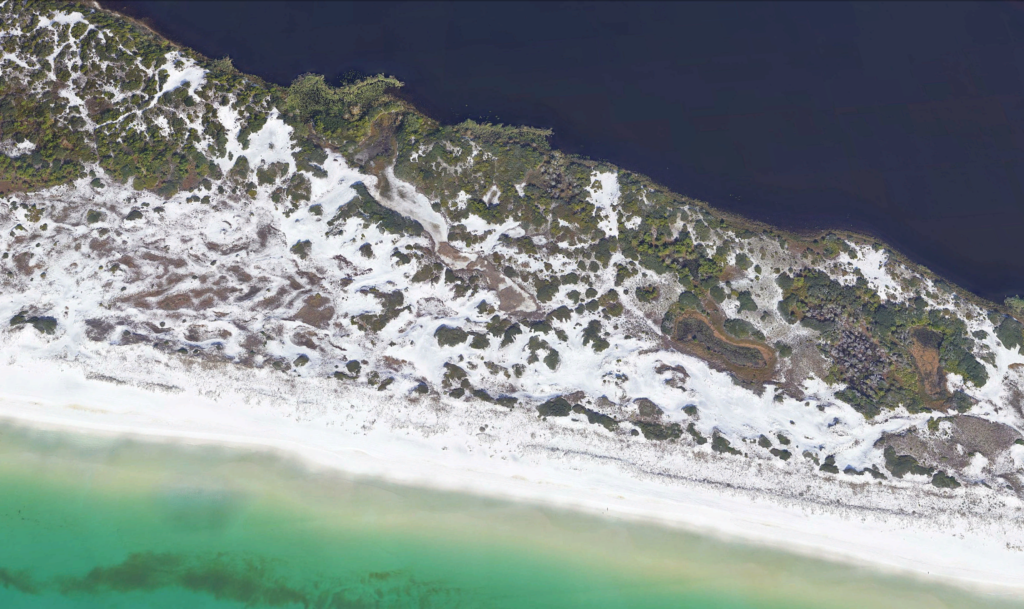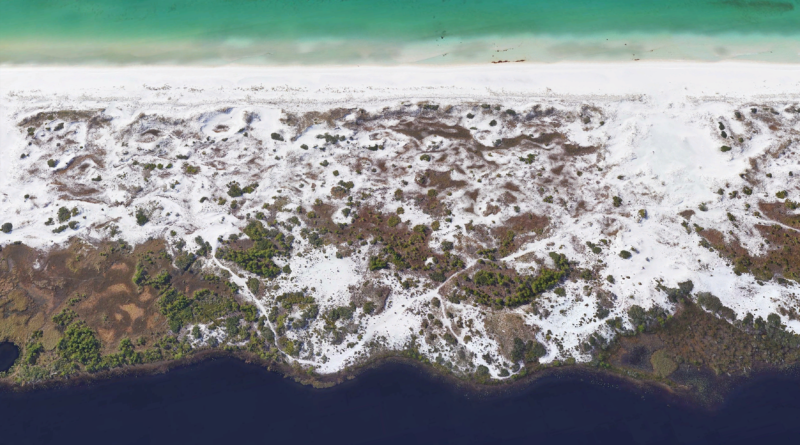Topsail Hill Preserve State Park: Where History Meets Coastal Splendor

Topsail Hill Preserve State Park: Where History Meets Coastal Splendor
Topsail Hill Preserve State Park, aptly named for a majestic dune that mimics the billowing sail of a ship, offers visitors a unique blend of historical significance and breathtaking natural beauty. Standing at an impressive twenty-five feet above sea level, the park’s namesake dune sets the stage for an exploration of 3.2 miles of secluded, white sand beaches, three coastal dune lakes, and coastal forests.
Historical Layers: Unveiling the Past of Topsail Hill Preserve State Park
As visitors traverse the sun-kissed shores of Topsail Hill Preserve State Park, they embark on a journey through time, uncovering the rich tapestry of history woven into the very fabric of this coastal haven. From evidence found in midden mounds – discarded debris from Native American communities – to remnants of a once-thriving turpentine industry and the echoes of World War II, each layer reveals a unique chapter in the park’s storied past.
Native American Presence:
Long before state park designations and conservation efforts, Native Americans recognized the bounty of resources that Topsail Hill offered. Evidence from midden mounds and a large adjacent mound indicates that Native Americans utilized this area for fishing, hunting, and camping. The freshwater coastal dune lakes, Choctawhatchee Bay, and the Gulf of Mexico provided an abundance of food and natural resources, allowing Native Americans to establish semi-permanent camps along this pristine coast.
Quarters Turpentine Village:
In the late 1800s to the mid-1900s, the landscape around Topsail Hill underwent a transformation as workers from the Quarters Turpentine Village harvested resin from old-growth longleaf pines. Turpentine, a vital component for maintaining wooden ships, was extracted by carving cat-face patterns into the trees. Metal strips were inserted to facilitate sap flow into clay pots. Today, the cat-face scars still adorn many living trees in the park, serving as tangible reminders of an era when the forest contributed to maritime trade and transportation.
World War II and Munitions Testing:
During World War II, Topsail Hill took on a new role as the western portion of the preserve became a munitions testing range for the development of the first missiles in the United States. Iron and rebar tracks were laid down, allowing trucks to traverse the soft sand to access the launch testing sites on the sandy beach and dunes. The remnants of these tracks are still visible today, especially along the hiking trail south of Morris Lake. This period of military history adds a unique layer to Topsail Hill’s narrative, showcasing the park’s adaptability and resilience across different epochs.
Ecological Diversity:
Beyond its historical significance, Topsail Hill Preserve State Park is celebrated for its diverse ecosystems, encompassing pristine beaches, freshwater coastal dune lakes, old-growth longleaf pine forests, and wetlands. The park’s 1,640-acre expanse provides a haven for a variety of plant and animal species, showcasing the delicate balance between conservation efforts and recreational exploration.
Topsail Hill Preserve State Park stands as more than a picturesque destination along 30A; it is a living testament to the intersection of human history and the natural world. From Native American communities to turpentine workers and wartime testing, the park’s history is as varied as its ecosystems. As visitors explore the trails, beaches, and remnants of the past, they become part of the ongoing story, contributing to the legacy of preservation and appreciation for the diverse history that has shaped Topsail Hill into the coastal gem it is today.
Beach Bliss and Angler’s Paradise:
For those seeking sun-soaked relaxation, Topsail Hill Preserve State Park beckons with 3.2 miles of pristine beaches. Lifeguards may be absent, but the sense of seclusion and tranquility is unmatched. Anglers can cast their lines along the beach, but it’s important to note that a Florida saltwater fishing license is required for individuals aged 16 to 65. Boats are prohibited, preserving the serenity of the coastline.
Trails and Nature Exploration:
The Morris Lake Nature Trail, a scenic 2.5-mile walk winding along Morris Lake and ancient coastal dunes, offers hikers a peaceful immersion in the park’s natural wonders. The Campbell Lake multi-use trail, leading from the tram station to Campbell Lake, caters to hikers and bicyclists alike. Abandoned jeep trails provide additional hiking opportunities, allowing visitors to traverse the diverse landscapes of Topsail Hill.
Convenient Access and Educational Offerings:
A tram shuttles visitors to the beach from the day-use parking area, offering a convenient way to reach the sandy shores. Alternatively, visitors can opt for a leisurely walk or bike ride down the shared-use trail. Nature hikes and educational programs, scheduled regularly, provide deeper insights into the park’s ecology and history. The ranger station is a valuable resource for more information on these offerings.
Campsites and Accommodations:
For those desiring an extended stay, Topsail Hill Preserve State Park accommodates a variety of camping options. RV enthusiasts will find campsites equipped to handle vehicles up to 45 feet long, complete with sewer, water, electric, cable, bathhouses, a swimming pool, shuffleboard, and beach access. Tent campers have their choice of 22 tent-only sites with water and electric services. Additionally, cabins are available for daily and weekly rentals, providing a comfortable retreat amidst the natural splendor.
In essence, Topsail Hill Preserve State Park isn’t just a destination; it’s a multifaceted experience that blends history, ecology, and recreational opportunities. Whether basking on the beaches, hiking the trails, or camping beneath the stars, visitors to Topsail Hill can immerse themselves in the diverse offerings of this coastal gem on 30A.
Get out and Explore30A!




